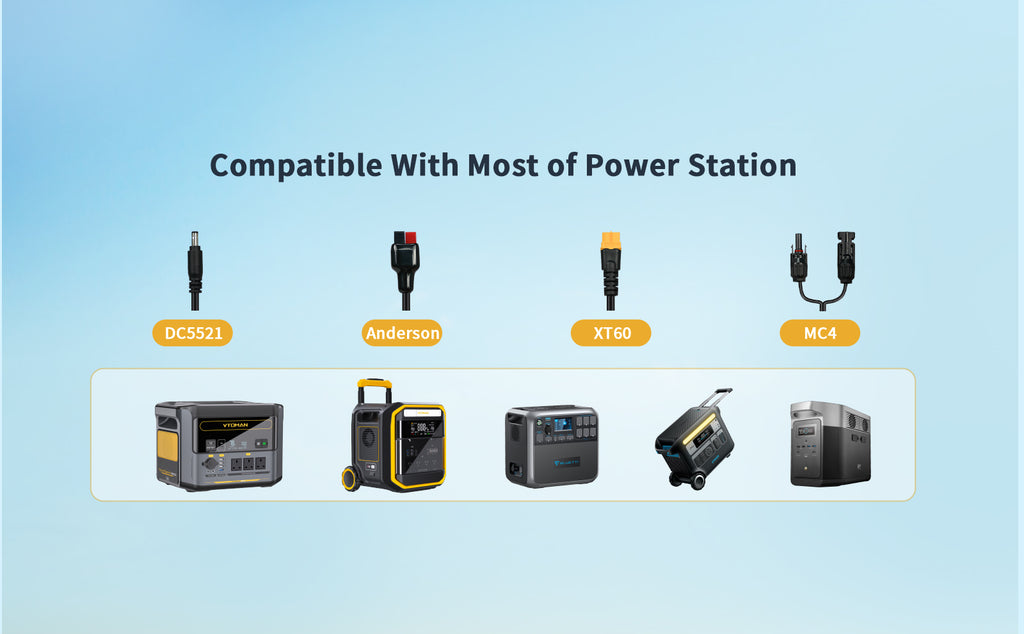Quick Answer: Portable solar generators typically cost between $200 to $2,000, suitable for casual or emergency use. In sharp contrast, standalone solar generators range from $1,000 to $30,000, but when considering installation (10-30% of system cost) and annual maintenance (1-2% of system cost), the total initial cost can increase notably. For example, a $30,000 standalone system might incur up to $9,000 in installation fees and $600 annually for maintenance, pushing the initial expenditure to around $39,000.
Costs By Solar Generator Types
Solar generators come in different types and capacities, catering to diverse needs and applications. Generally, we classify them into portable solar generators and standalone solar systems.
- Portable Solar Generators: These are compact, lightweight, and designed for mobility. Ideal for camping, outdoor activities, or emergency backup, portable solar generators typically range from $200 to $2000. Their capacity and the quality of solar panels significantly influence the price. Lower-end models provide basic power for charging small devices, while high-end versions can run several appliances simultaneously.
- Standalone Solar Generators: Unlike their portable counterparts, standalone systems are meant for residential or commercial use, providing a significant portion, if not all, of a property's electricity needs. Prices can vary widely, from $1,000 for small, DIY kits to over $30,000 for large-scale systems capable of powering an entire home. These systems are complex, including solar panels, battery storage, inverters, and often additional equipment like charge controllers and mounting hardware.
Factors That Influence the Costs of Solar Generators
The pricing of solar generators is not arbitrary; it reflects a range of elements that contribute to their value and performance. Here, we dissect the primary factors determining these costs, providing a clearer understanding for potential buyers.
Capacity and Power Output
The core functionality of a solar generator lies in its ability to generate and store energy. This capability is quantified in watt-hours (Wh) or kilowatt-hours (kWh), serving as a direct measure of the device's power output over time. Generally, a higher capacity equates to a higher price. For instance, a compact, lightweight generator designed for charging smartphones and laptops will cost significantly less than a robust model capable of powering household appliances for several hours. Consumers should consider their solar energy needs against the generator's capacity to ensure they are not overpaying for unnecessary power or underestimating their requirements.
Quality of Components
The components of a solar generator, such as solar panels, batteries, and electronic controls, play pivotal roles in its overall performance and longevity. Premium materials and advanced technology contribute to higher costs. However, they also ensure greater efficiency, meaning more electricity is generated from the same amount of sunlight. Furthermore, durable components are less susceptible to wear and tear, extending the generator's lifespan and reducing the need for costly replacements. Thus, while high-quality components elevate the initial investment, they can provide savings and superior service over time.
Brand and Warranty
The brand name carries weight in the solar generator market, as established brands with positive reputations typically command higher prices. This premium is often justified by the reliability of their products, backed by thorough testing and customer support. Warranties, correlating with the brand's confidence in their product, also influence cost. A longer warranty period signals a commitment to product longevity and customer satisfaction, offering peace of mind but at a premium. While costlier, opting for a reputable brand with a comprehensive warranty can avert future headaches and unforeseen expenses.
Additional Features and Accessories
The baseline functionality of solar generators can be significantly enhanced with additional features and accessories, which, while improving convenience and versatility, also add to the price. For example, integrated inverters allow the direct use of AC devices, waterproof casings protect against environmental damage, and multiple output ports enable the simultaneous charging of various devices. Additionally, expanding a system with extra solar panels or battery packs for increased capacity or backup power will further escalate the total cost. Therefore, while these enhancements can provide significant benefits, they should be selected based on actual needs to avoid unnecessary expenditures.

Installation and Maintenance
Particularly for standalone, residential, or commercial solar systems, installation can be a substantial portion of the overall cost. Installation costs can vary widely, generally ranging from 10% to 30% of the total system price, depending on several factors:
- Complexity of Installation: The design and requirements of the solar system can greatly affect installation costs. For a basic small-scale setup, installation might only represent a small fraction of the overall cost, perhaps around $1,000 to $3,000. However, for more sophisticated systems with higher capacities, the installation can ascend to $5,000 or more, especially if structural modifications or complex electrical work are required.
- Professional Installation Fees: The expertise required for installing solar generators varies by system size and complexity. For large, standalone systems, professional installers typically charge between $15 and $30 per square foot. This fee includes labor, wiring, mounting hardware, and ensuring everything meets local building codes and safety standards.
- Geographical Location: Labor costs and permitting fees can vary significantly based on geographic location. Urban areas often have higher rates due to increased labor costs, while remote areas might incur additional charges due to travel time and transportation of materials.
Regarding maintenance, solar generators have an advantage over traditional generators due to their fewer moving parts and reliance on sunlight-a free and abundant resource. However, they are not entirely maintenance-free. The annual maintenance cost for a solar generator system typically ranges from 1% to 2% of the total system cost. For a $10,000 system, this translates to $100 to $200 per year. Maintenance tasks may include cleaning solar panels, checking and replacing wires, and ensuring batteries and other components are functioning correctly.
Moreover, battery replacement is a significant maintenance cost in solar power systems. Depending on the type of battery, usage, and maintenance, solar batteries can last between 5 to 15 years. With the average cost of a solar battery pack ranging from $500 to $2,000, this can be a considerable long-term cost to factor into the total cost of ownership.
Why You Should Choose Portable Solar Generators
Given the substantial initial costs associated with standalone solar generators, not to mention the expenses tied to installation and ongoing maintenance, it's understandable that these options might not suit everyone's needs or budgets. Particularly for individuals without specific demands necessitating a standalone unit, portable solar generators present a more financially accessible and user-friendly alternative.
Portable solar generators negate the need for professional installation and significantly reduce ongoing maintenance costs, making them an attractive option for a broad range of users. They offer the convenience of plug-and-play operation with the added advantage of mobility, allowing owners to easily move them as needed for various applications, from outdoor adventures to emergency backup power.
Best Budget Solar Generators for 2024
The FlashSpeed 1500W/1548Wh 400W Solar Generator rises as the best choice for anyone in 2024 looking for a cost-effective yet potent portable solar power solution. With a competitive price of $1,398, this unit strikes a perfect balance between affordability, efficiency, and portability, making it an ideal investment for a wide demographic. The FlashSpeed 1500 stands out with its substantial output power of 1500W and a hefty energy capacity of 1548Wh, scaling up to an impressive peak of 3000W. This makes it exceedingly versatile, capable of catering to a broad spectrum of energy requirements from merely charging handheld devices to running significant household appliances efficiently.
Moreover, the FlashSpeed 1500 distinguishes itself with remarkable fast-charging capabilities, achieving full charge rapidly within just one hour using 1500W AC input. For eco-conscious users preferring solar charging, it supports a 400W solar input, promising full recharge within 4-6 hours under optimal conditions. Additionally, the device's capacity expansion feature is a game-changer, allowing users to double its storage with an Extra Battery, hence extending device runtime substantially. The generator's less than 20 milliseconds switchover time for its Uninterrupted Power Supply (UPS) function ensures that essential devices like CPAP machines and refrigerators remain operational during outages, preventing data loss and spoilage. Coupled with an innovative stackable design for easy transport and space efficiency, and fortified with a SuperSafe LiFeBMS System plus a durable LiFePO4 battery, the FlashSpeed 1500 promises safety, longevity, and over 3100 cycles of use.
In light of these remarkable features, if you're aiming to integrate solar power into your life without the extensive investment associated with standalone systems, the FlashSpeed 1500W/1548Wh 400W Solar Generator is your go-to option. Check out the FlashSpeed 1500 today and step into the future of portable, reliable, and eco-friendly energy solutions. Don't miss this chance to elevate your energy independence with VTOMAN's cutting-edge technology.













